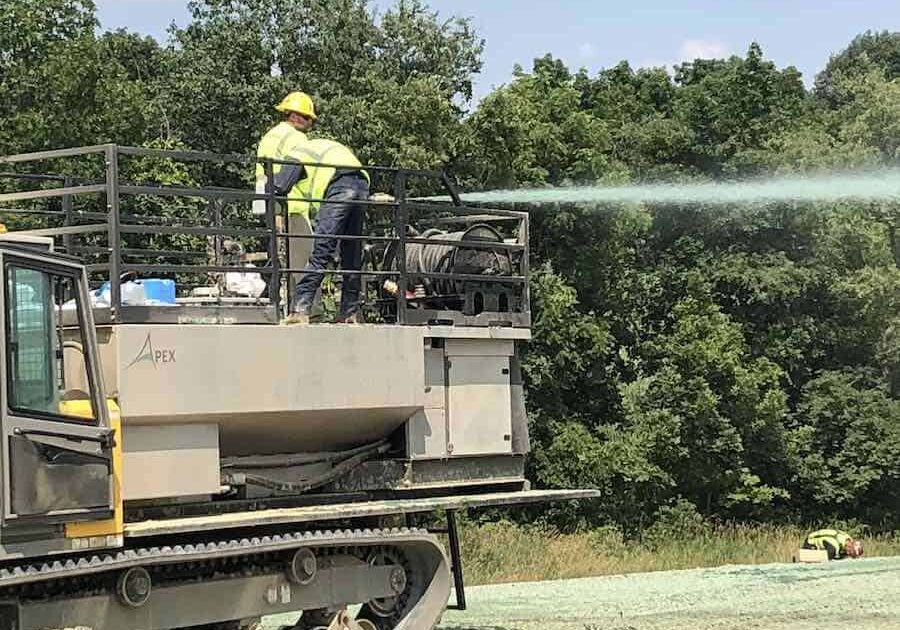How to Choose a Hydroseeder

Share this article!
The needs for commercial hydroseeding have evolved quite a bit since the first machines were used. With the introduction of new technologies like jet agitation and hydraulics, hydroseeders have changed from fairly simple machines to more complex ones that can handle different types of slurries and mulches, and can complete much bigger jobs than they once could.
Many of these hydroseeder evolutions, and the resulting machines, are suited for particular purposes. Jet agitation, for example, makes a hydroseeder well-suited for jobs that require easy-to-mix slurries like paper mixes, while hydroseeders with mechanical or paddle agitation can handle thicker slurries and mulches for jobs that need serious erosion control.
With the exception of jet agitation hydroseeders, most any hydroseeder can be adapted to do any job, but choosing the right machine for the job can mean you’ll save significant amounts of time, energy, and money. Let’s dive in to how to choose a hydroseeder.
1. Decide How Big Your Hydroseeder Should Be
Size should be one of the first considerations when choosing the right hydroseeding equipment. Very simply, how big are the seeding jobs you’ll be doing? The answer to this question can help you narrow down the types of equipment you should look at.
Hydroseeders for Small or Residential Hydroseeding Jobs
Small jobs, like residential landscaping, can often benefit the most from a small hydroseeder. A larger commercial hydroseeder generally just won’t be necessary, or cost effective, for an independent landscaping company working on residential lawns or mid-sized business parks.
The largest machine recommended for applications like this would be something like the Apex XA1200. With a 1200 gallon tank size and discharging at distances of more than 185 feet, midsized hydroseeding machines like this can handle just about any residential job a landscaper may come across quickly and effectively.
Hydroseeders for Large or Commercial Hydroseeding Jobs
By contrast, large hydroseeders can have very quick returns on investment for large-scale projects like highway construction or landfill operations. There’s a reason commercial hydroseeders are some of the biggest in the business — they’re built large and tough to tackle the biggest jobs out there.
The Apex XA330, 4000, and 5000 are the largest hydroseeder models available from Apex, and come with a liquid capacity of 3,260, 3,950, and 4,470 gallons, respectively. These can also discharge at distances up to 325 feet, making them powerful workhorses for large-scale projects like highway projects, commercial construction, and landfill application of Alternative Daily Covers (ADCs).
2. Select the Right Agitation Method
There are two basic types of hydroseeders, and they’re differentiated by the type of agitation system they use.
Jet agitation systems use pressurized water to mix the slurry inside the tank, while mechanical or paddle agitation systems use a paddle system to physically break apart materials, like straw or wood or fiber mulch, in the tank.
Pros and Cons of Jet Agitation Hydroseeders
Jet agitation hydroseeders have several advantages that can make them great entry-level hydroseeders for someone new to the industry. They tend to be easy to use and relatively low maintenance where hydroseeders are concerned.
Because of their construction, jet agitation hydroseeders work best with thinner slurries like paper mulch or wood-paper blends. Jet agitators aren’t powerful enough to handle materials like BFMs (Bonded Fiber Matrix) or the full bales of hay that are commonly used in large projects like erosion control hydroseeding.
Pros and Cons of Mechanical Agitation Hydroseeders
Mechanical agitation hydroseeders are the hydroseeder’s hydroseeder, they’re tough, dependable and can be used with the thickest slurries, hays, and mixes around. That’s why Apex carries only mechanical agitation hydroseeders. That said, like any product, there are both advantages and challenges that come with using mechanical agitation.
The main benefit to mechanical agitation hydroseeders like Apex’s XA1200 and larger series is the ability to dump full bales into the tank without having to break apart the loading material first, as the paddles are tough enough to break it apart effectively for the slurry. They’re the most versatile hydroseeders, since they can handle any type of slurry from 100% wood mulches to BFMs.
A key challenge landscapers run into with mechanical agitation hydroseeders is that they can require more maintenance than their jet agitation counterparts, as there are more parts that require attention.
What Agitation System is Best?
Deciding which agitation system is best depends heavily on what you’ll be using your hydroseeder for. For most large and commercial jobs, erosion control hydroseeding, and landfill applications, a mechanical agitation system will be more dependable and give you better results.
For smaller-scale landscapers and residential uses, a jet agitation system can be more than sufficient since these applications generally use thinner slurries and can be used by a smaller team of people.
3. Determine the Best Hydroseeder for Your Budget
How much you have to spend on a hydroseeder can help you narrow down the right piece of equipment for your job. Keep in mind, a small hydroseeder can theoretically cover a large area, but you’ll be spending more time and resources to do it, where a larger machine may initially be more of an investment, but you’ll be able to complete large jobs more quickly and with fewer resources, so you’ll be able to recoup your costs on the hydroseeder in less time.
Cost
Hydroseeders can run the gamut of pricing, depending on what you’re looking for. For example, a small, used hydroseeder can be in the neighborhood of $10,000, while new, commercial machines can top $100,000.
The key is to know what you need, and have narrowed down your choices of models and brands. It’s also worthwhile to have factored in how long it may take you to pay off the equipment cost, or know how many jobs you’ll need to take on to cover the costs.
Renting a hydroseeder or purchasing a used hydroseeder can also be a cost-effective option, especially if you’re infrequently contracting hydroseeding work, or have jobs you know only come up quarterly, etc. Check your local hydroseeding dealers, rental shops, or places like Machinery Trader to see where the best deals are.
Maintenance
Like any good piece of heavy machinery, hydroseeders will last a lot longer, and run much more efficiently if you take care of them. Most machines will come with a manual that details the maintenance plans, how to care for them in between scheduled maintenance, as well as tips for winterizing machines and storing them in the off season.
The different makes, models, and brands of hydroseeder all require different levels of maintenance, so it’s a good idea to make sure your comfort level with completing the required and recommended maintenance matches up with the machine’s specifications before you purchase one.
Warranty
Hydroseeders often also come with warranties covering incidental damage or parts replacement. Again, this is heavily dependent on the make, model, and brand of hydroseeder you choose.
Be sure to read through the manual thoroughly before deciding on a hydroseeder, so you understand exactly what’s covered, and what’s not. For example, Apex machines are covered under a base warranty for 12 months or 1,000 hours of use from the date of delivery. Two year limited warranties are also common.
Many manuals can be also found online through the various dealers, so if you’re looking at used machinery you can still see what might have been covered in the original warranty, if it’s still honored.
What is the Best Brand of Hydroseeder?
The best brand of hydroseeder will always be the brand that makes the right hydroseeder for your job. Apex machines are heavy duty workhorses that excel in erosion control, heavy construction, and commercial building projects.
Other brands are built for smaller projects and residential jobs, and most are built well and can handle anything you might throw at them. The key is to make sure you know what you’re getting, that you can take care of it, and that you’ll have a warranty to cover you if any issues do come up.
The Best Hydroseeding Machine Depends on Your Needs
The right hydroseeder for you depends on the work you need it to do. If you’re unsure about the best choices for your specific hydroseeding projects, reach out to one of our professionals through our site to get more information, or to speak to an experienced dealer.
